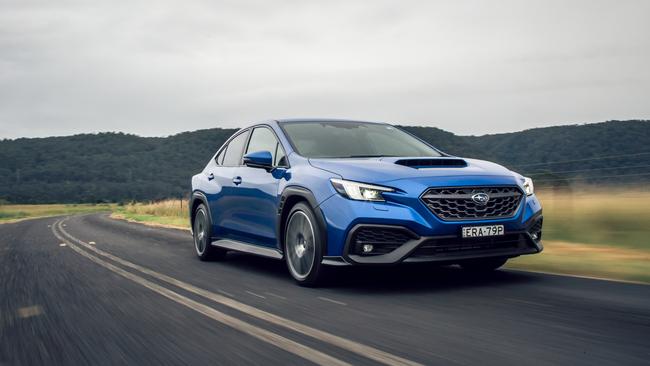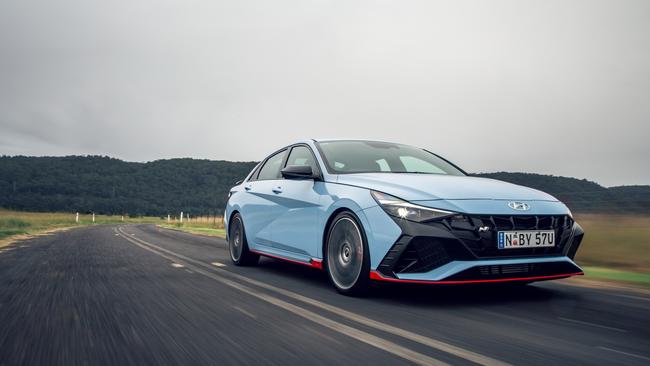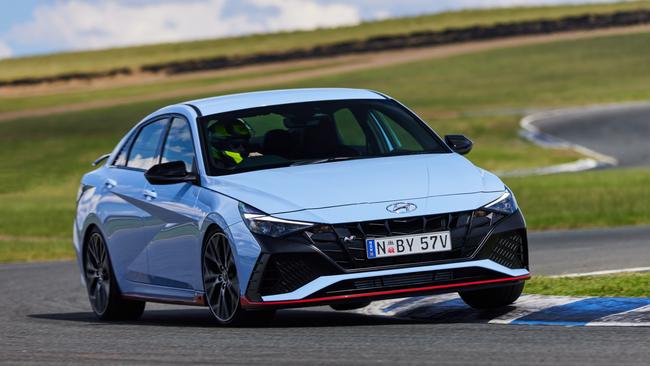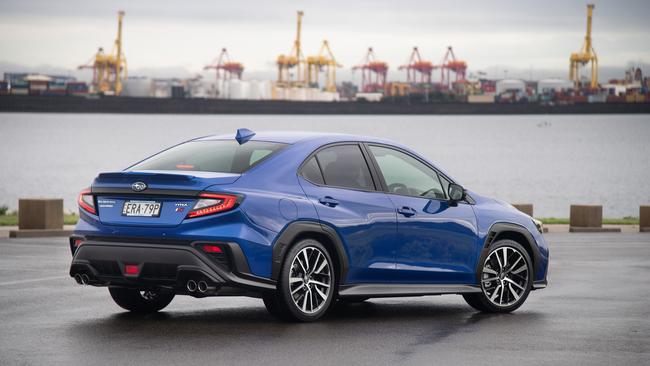Head to head: Hyundai i30 N Sedan vs Subaru WRX tS
Subaru’s WRX has developed a cult following over decades in Australia. A new challenger threatens to take its place as the best affordable performance car.
Motoring News
Don't miss out on the headlines from Motoring News. Followed categories will be added to My News.
There was a time when Subaru’s WRX ruled the roost in the world of compact performance cars.
It was the thinking driver’s alternative to the brutish homegrown V8s from Ford and Holden.
Fast forward two decades and the latest version of Subaru’s cult hero arrives in a market crowded with compelling alternatives, including the sedan version of the award-winning Hyundai i30 N.
We see how the two match up.

Subaru WRX
The original Rex was raw and unforgiving, but Subaru has refined the formula over the years.
It’s a far more sophisticated and comfortable car now.
The cabin is a little old-school, though. There’s no high-resolution digital screen in front of the driver, just a small readout between the tacho and the speedo.
A tablet-like vertical screen on the dash is easy to navigate and compatible with Apple CarPlay/Android Auto, while audiophiles are treated to an excellent 10-speaker Harman Kardon audio system, digital radio and an increasingly rare CD player.

The Subaru has the edge over its Hyundai rival inside, with higher quality materials and better attention to detail. Rear passengers have their own air vents, USB ports and a fold-down armrest.
Supportive suede front bucket seats have classy red stitching and WRX logos embossed in the head rests.
Subaru also marginally shades the Hyundai for driver aids. Both have excellent safety, but the Subaru has radar cruise control.

Performance cars are about performance, though, and the WRX isn’t the leap forward you’d expect from an all-new model.
Engine size has grown from 2.0 litres to 2.4 litres, but the bigger unit only makes an extra 5kW (202kW) and the same 350Nm of torque, albeit delivered lower in the rev range. Subaru claims the auto we tested can reach 100km/h in six seconds, but it didn’t feel that quick.

Subaru has persisted with a continuously variable transmission, a stepless auto that lacks the quick-witted precision of the Hyundai’s dual-clutch auto set-up. It’s fine for everyday driving but on a twisting road with low-speed corners, it can’t keep up with driver inputs. There are paddle shifters but it takes a while for the auto to get the message.
It’s a shame because the rest of the WRX is excellent.
The suspension is a little softer than the i30N, which means it leans more in corners, but it has loads of grip, great balance and precise steering.

Hyundai i30 N
The i30 N was a watershed car for Hyundai. The brand’s first real performance car proved it could mix it with the best in the hot-hatch market.
The i30 N sedan, built on a more modern platform, is even better. It retains the character of the original while adding more sophistication, comfort and ability.
The 2.0-litre four-cylinder turbo outpunches the Subaru’s turbo four with 206kW (and up to 213kW for short bursts on overboost) and 392Nm of torque. That’s just part of the performance story, though.

It weighs roughly 120kg less than the Subaru and its eight-speed auto intuitively picks the right ratio for maximum thrust out of corners, which means the Hyundai feels noticeably punchier off the mark. It can scrabble for grip on occasions if you’re too enthusiastic with the throttle, but overall it does an excellent job of transferring that much power to the tarmac through the front wheels. Hyundai claims a 0-100km/h time of 5.3 seconds and it feels much quicker than the Subaru by the seat of the pants.

It’s more eager to turn into corners than the Subaru as well, while the grip from its Michelin rubber is outstanding. Then there’s the soundtrack. While the Subaru whistles and whines, the Hyundai growls and barks on gear shifts. It’s simply a more engaging and rewarding drive.
The choice of six drive modes – adjusting suspension, throttle, steering and exhaust settings – adds appeal for enthusiasts, as do the data logging and racetrack map functions.
It’s not perfect though.

What Hyundai spent on the driving theatrics it saved on the cabin finishes. The digital screen in front of the driver lifts the ambience but you don’t have to look far to find evidence of penny pinching – cheap plastics and no USBs or armrest in the back.
It’s also noticeably firmer around town, picking up small imperfections in the road surface that the Subaru doesn’t.

It’s not devoid of luxuries, though. It has a wireless phone charging pad absent from the Subaru, and the front leather seats are heated and ventilated. Not bad considering the price tag is $7000 less than the WRX.
Verdict
A clear win to the Hyundai. It may not have the class of the Subaru inside, but it delivers more bang for the buck.

HYUNDAI i30 N PREMIUM
PRICE About $55,500 drive-away
ENGINE 2.0-litre four-cylinder turbo petrol, 206kW and 392Nm
WARRANTY/SERVICING Five years/unlimited km, $1675 over five years
SAFETY Six airbags, auto emergency
braking, blind-spot monitoring, lane-keep assist, rear cross traffic alert, rear seat occupant alert
THIRST 8.2 litres
per 100km
SPARE Temporary
LUGGAGE 464 litres

SUBARU WRX TS
PRICE About $62,600 drive-away
ENGINE 2.4-litre four-cylinder turbo petrol, 202kW and 350Nm
WARRANTY/SERVICING Five years/unlimited km, $2365 over five years
SAFETY Six airbags, auto emergency braking, blind-spot monitoring, lane-keep assist, rear cross traffic alert, rear seat occupant alert, radar cruise
THIRST 8.5L/100km
SPARE Space saver
LUGGAGE 411 litres
Originally published as Head to head: Hyundai i30 N Sedan vs Subaru WRX tS



